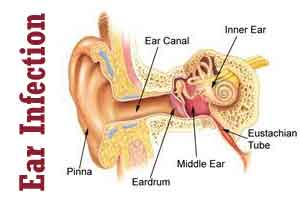- Home
- Editorial
- News
- Practice Guidelines
- Anesthesiology Guidelines
- Cancer Guidelines
- Cardiac Sciences Guidelines
- Critical Care Guidelines
- Dentistry Guidelines
- Dermatology Guidelines
- Diabetes and Endo Guidelines
- Diagnostics Guidelines
- ENT Guidelines
- Featured Practice Guidelines
- Gastroenterology Guidelines
- Geriatrics Guidelines
- Medicine Guidelines
- Nephrology Guidelines
- Neurosciences Guidelines
- Obs and Gynae Guidelines
- Ophthalmology Guidelines
- Orthopaedics Guidelines
- Paediatrics Guidelines
- Psychiatry Guidelines
- Pulmonology Guidelines
- Radiology Guidelines
- Surgery Guidelines
- Urology Guidelines
AAO-HNSF Updated Clinical Practice Guideline: Acute Otitis Externa

With one in every 123 people in the United States affected by Acute Otitis Externa or "swimmer's ear" each year, the American Academy of Otolaryngology-Head and Neck Surgery Foundation released an evidence-based guideline to improve the diagnosis and treatment. The clinical guideline for Acute Otitis Externa was created by a panel that included otolaryngologist-head and neck surgeons, pediatricians, infectious disease physicians, family medicine professionals, dermatologists, and consumer advocates.The guideline, updated from 2006, was published in the journal Otolaryngology-Head and Neck Surgery, the official scientific journal of the American Academy of Otolaryngology.
The use of topical treatment by antibiotic eardrops rather than oral antibiotics is among the recommendations made. The Foundation included this recommendation in the national Choosing Wisely® campaign, which encourages physicians and patients to talk about treatment options and pursue only those that are necessary and appropriate for an individual patient. The guideline makes eight recommendations in total.
FACT SHEET
What is Acute Otitis Externa?
- Acute Otitis Externa (AOE), commonly known as "swimmer's ear," is one of the most common infections encountered by clinicians, affecting 2.4 million people (1 in 123) annually in the United States, with regional variations based on age and geography.
- AOE is an infection of the outer ear, usually caused by bacteria that multiply when water becomes trapped in the ear canal. AOE is more common in warmer climates and in the summer months when people have increased exposure to water. Other factors that cause AOE include: skin conditions that may contribute to debris in the ear canal, trauma from aggressive ear cleaning, trauma from wearing hearing aids, sweating, allergies, and stress.
- Common symptoms of AOE are inflammation, itching, a feeling of fullness with or without hearing loss, and pain when tugging on the earlobe or chewing food.
- Treatment for AOE includes analgesics and eardrops, which include antiseptics, antibiotics, and corticosteroids, alone or in combination. Eardrops are highly effective because of the high local concentration of drug in the ear canal.
- Oral antibiotics are ineffective for AOE because the major pathogens are resistant to commonly used drugs and the concentration achieved in the ear canal is low compared to topical therapy.
- Strategies to prevent AOE are aimed at limiting water accumulation and moisture retention in the external ear canal and maintaining a healthy skin barrier.
Updates to the guideline include (since first publication in 2006):
- Addition of a dermatologist and consumer advocate to the guideline development group.
- Expanded action statement profiles to explicitly state confidence in the evidence, intentional vagueness, and differences of opinion.
- Enhanced external review process to include public comment and journal peer review.
- New evidence from 12 randomized controlled trials and 2 systematic reviews.
- Review and update of all supporting text.
- Emphasis on patient education and counseling with new tables that list common questions with clear, simple answers and provide instructions for properly administering eardrops.
What are significant points made in the guideline?
- Clinicians should distinguish diffuse AOE from other causes of otalgia, otorrhea, and inflammation of the external ear canal.
- Clinicians should assess the patient with diffuse AOE for factors that modify management (non-intact tympanic membrane, tympanostomy tube, diabetes, immunocompromised state, prior radiotherapy).
- The clinician should assess patients with AOE for pain and recommend analgesic treatment based on the severity of pain.
- Clinicians should not prescribe systemic antimicrobials as initial therapy for diffuse, uncomplicated AOE unless there is extension outside the ear canal or the presence of specific host factors that would indicate a need for systemic therapy.
- Clinicians should prescribe topical preparations for initial therapy of diffuse, uncomplicated AOE.
- Clinicians should inform patients how to administer topical drops and should enhance delivery of topical drops when the ear canal is obstructed by performing aural toilet, placing a wick, or both.
- When the patient has a known or suspected perforation of the tympanic membrane, including a tympanostomy tube, the clinician should prescribe a non-ototoxic topical preparation.
- If the patient fails to respond to the initial therapeutic option within 48-72 hours, the clinicians should reassess the patient to confirm the diagnosis of diffuse AOE and to exclude other causes of illness.

Disclaimer: This site is primarily intended for healthcare professionals. Any content/information on this website does not replace the advice of medical and/or health professionals and should not be construed as medical/diagnostic advice/endorsement or prescription. Use of this site is subject to our terms of use, privacy policy, advertisement policy. © 2020 Minerva Medical Treatment Pvt Ltd